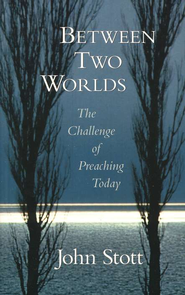
This book review of John Stott’s Between Two Worlds was written as part of Pastor Lane’s doctoral course work, and as such, it is written in a more formal, academic tone than the rest of this blog’s posts. Still, we hope the audience will find these academic book reviews useful, which is why we have published them for your reference.
John R. W. Stott was born in London to Sir Arnold and Emily Stott. His father was a leading physician and an agnostic. His mother was Lutheran in the Church of England. He studied modern languages at Trinity College, Cambridge, and went on to graduate with a degree in French and theology. Ordained in 1945, he became a curate at All Souls Church from 1945-1950, then rector 1950-1975. He grew up in this church and spent almost his whole life there, apart from a few years in Cambridge. He rose to national and international influence, and most notably in the dispute about evangelicals remaining in the Church of England, a debate that arose when he opposed Dr. Martin Lloyd-Jones call to leave the liberal churches. In 1975 he resigned as Rector of All Souls Church to focus on other projects. He remained at the church and was appointed Rector Emeritus. He retired in 2007 at the age of 86. He passed away on July 27, 2011, with family standing around his bed reading the Bible and listening to Handel’s Messiah. He remained celibate all his entire life. Christianity Today described him as “An architect of 20th century evangelicalism who shaped the faith of a generation.” At his death, which was reported in the secular media, the British Broadcasting Corporation described him as one who “could explain complex theology in a way lay people could easily understand.” Upon his death, memorial services were held, in addition to the one at All Souls Church, at locations in London, New Zealand, Wheaton, Illinois, and Toronto, Canada. He was an evangelical of the highest order.
 The purpose of Between Two Worlds is to address the vast topic of preaching by bringing together several complementary aspects that the author feels has too often been kept apart. Two other notable purposes he highlights is his emphasis on matters of first importance: theological and personal issues. As well, he seeks to highlight an emphasis on preaching as bridge-building. He is speaking directly to preachers but in a way that is valuable for anyone who would be interested in a comprehensive perspective on the matter.
The purpose of Between Two Worlds is to address the vast topic of preaching by bringing together several complementary aspects that the author feels has too often been kept apart. Two other notable purposes he highlights is his emphasis on matters of first importance: theological and personal issues. As well, he seeks to highlight an emphasis on preaching as bridge-building. He is speaking directly to preachers but in a way that is valuable for anyone who would be interested in a comprehensive perspective on the matter.
Between Two Worlds makes a significant contribution to the subject and study of preaching in a number of ways. First, the historical sketch that begins the book is an exceptional overview that is beneficial and insightful. Second, the author speaks from a long tenure of faithfulness in the preaching ministry. The book is seasoned with counsel and wisdom from one who has excelled in the craft of preaching and stands as a model scholar and theologian. Third, the amount of information from quotations and references is astounding. A wealth of information is compiled in this work that stands as resource for greater study. There are 499 references in eight chapters, for an average of 62 per chapter. One chapter has 101 notes. A lengthier consideration of this book by greater exploration of notes would prove greatly beneficial.
The general nature of this book is foundational, from theology and history, in demonstrating the thread of the preaching tradition, but inherent is also a strong philosophical mandate that the author puts forward for preaching and the role is serves. Though there is some technical information included, really more “what to do” rather than “how-to,” this is not the main focus of the book.
“The Glory of Preaching: A Historical Sketch” is a grand thread that begins with the statement “preaching is central and distinctive to Christianity,” and demonstrates the historical presence and importance of preaching, beginning with Jesus, the Apostles and early church fathers and following through every major period of history to the twentieth century. This chapter is a valuable resource that culminates a great amount of information for study and resource, seventy-three endnotes in this chapter alone, and helpful for any person seeking deeper study.
“Contemporary Objections to Preaching” addresses modern resistance to the role of preaching in three broad categories: the anti-authority mood, the cybernetics revolution, and the Church’s loss of confidence in the gospel. With each category the author offers an appropriate Christian response with guided counsel that helps one to rise above the issue and work to address it. There is a real sense of calm, seasoned wisdom in these pages that helps one not to overreact, but encourages strong biblical response. It would be best if the proponents of dialogical preaching would read and heed his words that the nature of the sermon is inherently dialogical, not that the form should be structured such a manner.
“Theological Foundations for Preaching” establishes an “indispensible necessity, for the glory of God and the food of the church, of conscientious biblical preaching” through five theological arguments: a conviction about God, about scripture, about the Church, about the pastorate, and about preaching. Between theological foundations and historical examples of how preachers throughout the ages were affected by these, he provides a compelling motivation that leaves one with little other than fire to preach as a mandate form God.
“Preaching as Bridge-building” is a chapter of particular interest to the author, as noted in the Introduction. This chapter compels the nature of our sermons to cross into culture and speak to the people of our times with the singular subject of Christ, “the fulfillment of every true human aspiration.” He appeals to biblical and historical precedents as well as the importance of personal Christian ethics and broader social and political issues. He even addresses our handling of hard, controversial questions and gives sound, Christ-specific counsel. This chapter is a wealth of resource and encouragement for anyone who takes serious their responsibility to be faithful to Scripture, preaching Christ with a genuine heart of compassion for people and the world.
“The Call to Study” begins the first of two most practical chapters that address not so much the “how-to” of sermon preparation, but rather the “what to do” to prepare a sermon. This emphasis is demonstrated by describing, more than telling, what we do. He states that our study must be comprehensive, open-minded, and expectant. He also includes, what some would disagree with, our need to study the world around us along with the Bible, stating that a preacher must know his people. Preacher must ask questions and learn from their people. As well, he recommends a study group with other pastors to enrich and strengthen one’s understanding and application. He also addresses some hindrances to the preachers study. This chapter, though not a textbook on sermon preparation, is an excellent resource of ideas and guidance that approaches this matter from a unique perspective.
“Preparing Sermons” is the most instructive of the chapters, but still not highly technical in nature. His recommendations for choosing a passage are a bit different in that he does not make a strong case for preaching through books of the Bible, though he does practice it. As well, though he describes expositional preaching, he does so in much broader terms, avoiding more rigorous technical details. And, though describing much the same process, this is very different than many more modern texts of expository preaching.
“Sincerity and Earnestness” is best described by simply saying that the preacher must mean what he says and live what he preaches. This is to say “the practice of preaching cannot be divorced from the person of the preacher.” How the preacher presents himself, and all the many issues involved, are mostly covered here. How important this chapter is at a time when too many preachers have become professionals, divorcing their work form their life. More than just the impact it has on others when sin is revealed in the life of a preacher, is the preacher who remains and continues to preach without any power.
“Courage and Humility” brings a great conclusion to this book. In true form with the book, he begins with biblical and historical examples to introduce. Most important, he explains why courage and humility are important by listing the need to comfort and disturb and the need to practice systematic exposition for our own discipline. He finishes by exploring the value of humility — the “chief occupational hazard” for the preacher — and how it prepares them to be fully used of God. Humility saves the preacher from being neither closed or critical, helps to avoid adding to or taking away from scripture, better ensures pure motives, and keeps one dependent on Holy Spirit’s power. This chapter is a great conclusion that leaves the reader in a proper place before God to end a classic work.
Dr. Stott’s writing style is plain and straightforward, making it very readable. The manner in which the material is organized also makes it easy to see and accessible in review. He incorporates a great amount of material, but it does not feel tedious or burdensome in reading. Rather, it broadens the perspective of the point he is making.
I am most enthusiastic about three aspects of this book. First, the historical sketch is great. It whets the appetite for further study and research. Second, his treatment of the objections to preaching could not be more appropriate for the day and time in which we live. Considering when he wrote the book, 1982, the thirty years that have since ensued have only bred greater expressions of this same resistance. This message must be renewed in the church today to counter the poor expressions that are now being propagated and offered as substitutes. Third, the bridge-building aspect of preaching becomes a greater necessity every day. The pulpit must speak to the issues of the day with the gospel. This chapter gives great principles and counsel for a preacher to create a discernment paradigm to think through how best to address current issues that arise from God’s Word.
More book reviews by Pastor Lane